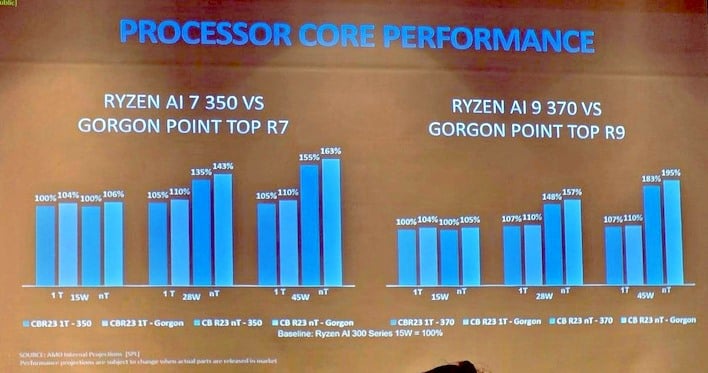AMD Gorgon Point Mobile APU Spotted With Zen 5 And RDNA 3.5

The first slide explicitly names Gorgon Point as a refresh of the existing Strix Point lineup. The chips range from Ryzen AI 9 HX down to Ryzen AI 3, but interestingly, no model numbers are provided—only their market positioning. Compared to Strix Point, the only notable change is a 100 MHz boost to max clock speeds for the top-end Ryzen AI 9 HX and Ryzen AI 7 models, raising their peak from 5.1 GHz to 5.2+ GHz.
The third slide shows Cinebench R23 single- and multi-threaded performance figures, using an existing Ryzen AI 300-series chip at 15W as the baseline (100%). The chart is jumbled, but if we're reading it correctly, single-threaded performance sees a modest 3-5% uplift over Strix Point while multi-threaded gains range from 6% to 12%. These gains are almost certainly due to the slightly higher clock speeds, since the core architecture remains unchanged as we just discussed.
Alongside this info, 포시포시 also confirmed that the previously-leaked Medusa family will include a "Halo" tier—a direct successor to the current Strix Halo (Ryzen AI Max 300 Series). This is promising, because we just reviewed the ASUS ROG Flow Z13 with a Ryzen AI MAX+ 395 onboard that delivered insane performance for an 80W tablet. Strix Halo is definitely a bit of a niche product, but this seems to indicate that AMD is carrying on with it, to our delight.
Still, despite this early leak, it seems like Gorgon Point won’t hit the market until 2026, meaning we’re still at least eight months out from its arrival. Given the minimal improvements, those needing an upgrade sooner should probably consider current Strix Point-based options (or perhaps a Qualcomm or Intel machine, depending on your needs) rather than waiting.





